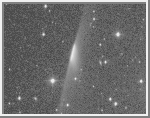|
COMETS EARTH JUPITER KUIPER BELT MARS MERCURY METEORITES NEPTUNE OORT CLOUD PLUTO SATURN SOLAR SYSTEM SPACE SUN URANUS VENUS ORDER PRINTS
PHOTO CATEGORIES SCIENCEVIEWS AMERICAN INDIAN AMPHIBIANS BIRDS BUGS FINE ART FOSSILS THE ISLANDS HISTORICAL PHOTOS MAMMALS OTHER PARKS PLANTS RELIGIOUS REPTILES SCIENCEVIEWS PRINTS
|
Related Document
Download Options
This is an image obtained with the 0.91-meter Spacewatch Telescope of the University of Arizona Observatories on Kitt Peak in Arizona by Jim Scotti, on 1993 March 30 at a mid-time of 07:26:13 UT. The total integration time was 440 seconds. North is to the right and East is at the top. The image scale is 1.076 arcseconds per pixel and the field of view is 9.2 arcminutes, approximately square. Note the various structures visible in this image. Namely, the train of individual nuclei aligned along a position angle of 77 to 257 degrees. Approximately 11 nuclei are visible in this image of the train, spread out over 51 arcseconds (or about 170,000 kilo- meters). A tail extends from each of the nuclei approximately 1 arcminute towards p.a. 285 degrees, with a brighter component extending from the brightest nucleus out to about 1.2 arcminutes. Dust trails extend off the edges of the fram to more than 10 arcminutes in p.a. 260 degrees and 6 arcminutes in p.a. 75 degrees. Notice also that the southern margin of the dust trails is relatively sharp while the northern margin is more diffuse. This may be due to smaller particles being blown off by the solar wind. |
